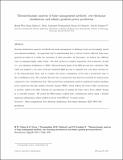Thermodynamic analysis of brine management methods: Zero-discharge desalination and salinity-gradient power production
Author(s)
Chung, Hyung Won; Nayar, Kishor Govind; Swaminathan, Jaichander; Chehayeb, Karim Malek; Lienhard, John H
DownloadCHUNG-Brine_Management-Desalination-2017-preprint.pdf (14.01Mb)
OPEN_ACCESS_POLICY
Open Access Policy
Creative Commons Attribution-Noncommercial-Share Alike
Terms of use
Metadata
Show full item recordAbstract
Growing desalination capacity worldwide has made management of discharge brines an increasingly urgent environmental challenge. An important step in understanding how to choose between different brine management processes is to study the energetics of these processes. In this paper, we analyze two different ways of managing highly saline brines. The first method is complete separation with production of salts (i.e., zero-discharge desalination or ZDD). Thermodynamic limits of the ZDD process were calculated. This result was applied to the state-of-the-art industrial ZDD process to quantify how close these systems are to the thermodynamic limit, and to compare the energy consumption of the brine concentration step to the crystallization step. We conclude that the brine concentration step has more potential for improvement compared to the crystallization step. The second brine management method considered is salinity-gradient power generation through pressure-retarded osmosis (PRO), which utilizes the brine's high concentration to produce useful work while reducing its concentration by mixing the brine with a lower salinity stream in a controlled manner. We model the PRO system coupled with a desalination system using a detailed numerical optimization, which resulted in about 0.42 kW h/m3 of energy saving.
Date issued
2016-11Department
Massachusetts Institute of Technology. Department of Mechanical Engineering; Rohsenow Kendall Heat Transfer Laboratory (Massachusetts Institute of Technology)Journal
Desalination
Publisher
Elsevier B.V.
Citation
Chung, Hyung Won, Kishor G. Nayar, Jaichander Swaminathan, Karim M. Chehayeb, and John H. Lienhard V. “Thermodynamic Analysis of Brine Management Methods: Zero-Discharge Desalination and Salinity-Gradient Power Production.” Desalination 404 (February 2017): 291–303.
Version: Author's final manuscript
ISSN
00119164
1873-4464